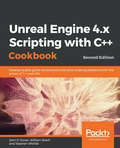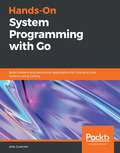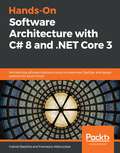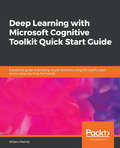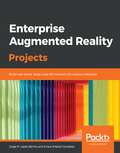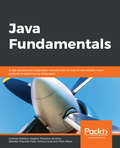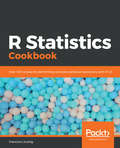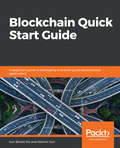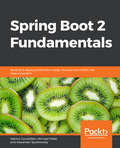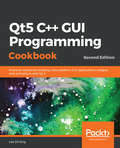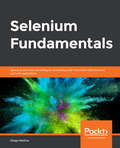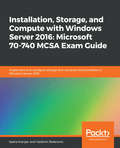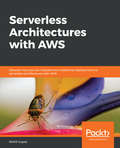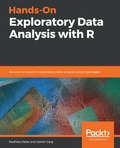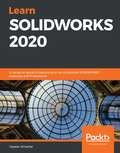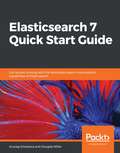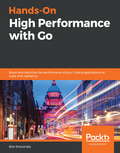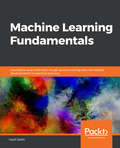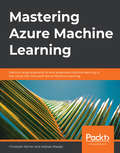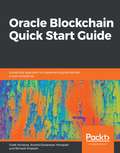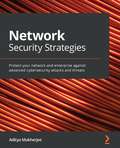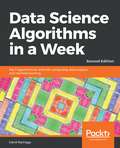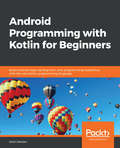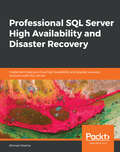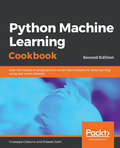- Table View
- List View
Unreal Engine 4.x Scripting with C++ Cookbook: Develop quality game components and solve scripting problems with the power of C++ and UE4, 2nd Edition
by William Sherif Stephen Whittle John P. DoranWrite efficient, reusable scripts to build custom characters, game environments, and control enemy AI Key FeaturesBuild captivating multiplayer games using Unreal Engine and C++Incorporate existing C++ libraries into your game to add extra functionality such as hardware integrationPractical solutions for memory management, error handling, inputs, and collision for your game codebaseBook DescriptionUnreal Engine 4 (UE4) is a popular and award-winning game engine that powers some of the most popular games. A truly powerful tool for game development, there has never been a better time to use it for both commercial and independent projects. With more than 100 recipes, this book shows how to unleash the power of C++ while developing games with Unreal Engine.This book takes you on a journey to jumpstart your C++ and UE4 development skills. You will start off by setting up UE4 for C++ development and learn how to work with Visual Studio, a popular code editor. You will learn how to create C++ classes and structs the Unreal way. This will be followed by exploring memory management, smart pointers, and debugging your code. You will then learn how to make your own Actors and Components through code and how to handle input and collision events. You will also get exposure to many elements of game development including creating user interfaces, artificial intelligence, and writing code with networked play in mind. You will also learn how to add on to the Unreal Editor itself. With a range of task-oriented recipes, this book provides actionable information about writing code for games with UE4 using C++. By the end of the book, you will be empowered to become a top-notch developer with UE4 using C++ as your scripting language!What you will learnCreate C++ classes and structs that integrate well with UE4 and the Blueprints editorDiscover how to work with various APIs that Unreal Engine already containsUtilize advanced concepts such as events, delegates, and interfaces in your UE4 projectsBuild user interfaces using Canvas and UMG through C++Extend the Unreal Editor by creating custom windows and editorsImplement AI tasks and services using C++, Blackboard, and Behavior TreesWrite C++ code with networking in mind and replicate properties and functionsWho this book is forIf you are really passionate game developer looking for solutions to common scripting problems, then this is the book for you. Understanding of the fundamentals of game design and C++ is expected to get the most from this book.
Hands-On Systems Programming with Go: Build modern and concurrent applications for Unix and Linux systems using Golang
by Alex GuerrieriIf you are a developer who has intermediate knowledge of Go but little to no knowledge of UNIX and Linux system programming and want to learn and master system programming with Go, this book is for you.
Hands-On Software Architecture with C# 8 and .NET Core 3: Architecting software solutions using microservices, DevOps, and design patterns for Azure Cloud
by Francesco Abbruzzese Gabriel BaptistaDesign scalable and high-performance enterprise applications using the latest features of C# 8 and .NET Core 3 Key Features Become a software architect capable of creating modular apps for specific business needs Design high-performance software systems using the latest features of C# 8 and .NET Core 3 Solve scalability problems in web apps using enterprise architectural patterns Book Description Software architecture is the practice of implementing structures and systems that streamline the software development process and improve the quality of an app. With this software architecture book, you'll follow a hands-on approach to learning various architectural methods that will help you develop and deliver high-quality products. You'll begin by understanding how to transform user requirements into architectural needs and exploring the differences between functional and non-functional requirements. Next, you'll explore how to carefully choose a cloud solution for your infrastructure, along with covering dos and don'ts that will help you manage your app in a cloud-based environment. Later chapters will cover techniques and processes such as DevOps, microservices, and continuous integration, along with providing insights into implementing them using Microsoft technologies such as ASP.NET Core, the Entity Framework, Cosmos DB, and Azure DevOps. You will also learn about testing frameworks and automation tools that will help you through the development process. Finally, you'll discover design patterns and various software approaches that will allow you to solve common problems faced during development. By the end of this book, you'll be able to develop and deliver highly scalable enterprise-ready apps that meet customers' business needs. What you will learn Overcome real-world architectural challenges and solve design consideration issues Apply architectural approaches like Layered Architecture, service-oriented architecture (SOA), and microservices Learn to use tools like containers, Docker, and Kubernetes to manage microservices Get up to speed with Azure Cosmos DB for delivering multi-continental solutions Learn how to program and maintain Azure Functions using C# Understand when to use test-driven development (TDD) as an approach for software development Write automated functional test cases for your projects Who this book is for This book is for engineers and senior developers aspiring to become architects or looking to build enterprise applications with the .NET Stack. Experience with C# and .NET is required to understand this book.
Deep Learning with Microsoft Cognitive Toolkit Quick Start Guide: A practical guide to building neural networks using Microsoft's open source deep learning framework
by Willem MeintsLearn how to train popular deep learning architectures such as autoencoders, convolutional and recurrent neural networks while discovering how you can use deep learning models in your software applications with Microsoft Cognitive Toolkit Key Features Understand the fundamentals of Microsoft Cognitive Toolkit and set up the development environment Train different types of neural networks using Cognitive Toolkit and deploy it to production Evaluate the performance of your models and improve your deep learning skills Book Description Cognitive Toolkit is a very popular and recently open sourced deep learning toolkit by Microsoft. Cognitive Toolkit is used to train fast and effective deep learning models. This book will be a quick introduction to using Cognitive Toolkit and will teach you how to train and validate different types of neural networks, such as convolutional and recurrent neural networks. This book will help you understand the basics of deep learning. You will learn how to use Microsoft Cognitive Toolkit to build deep learning models and discover what makes this framework unique so that you know when to use it. This book will be a quick, no-nonsense introduction to the library and will teach you how to train different types of neural networks, such as convolutional neural networks, recurrent neural networks, autoencoders, and more, using Cognitive Toolkit. Then we will look at two scenarios in which deep learning can be used to enhance human capabilities. The book will also demonstrate how to evaluate your models' performance to ensure it trains and runs smoothly and gives you the most accurate results. Finally, you will get a short overview of how Cognitive Toolkit fits in to a DevOps environment What you will learn Set up your deep learning environment for the Cognitive Toolkit on Windows and Linux Pre-process and feed your data into neural networks Use neural networks to make effcient predictions and recommendations Train and deploy effcient neural networks such as CNN and RNN Detect problems in your neural network using TensorBoard Integrate Cognitive Toolkit with Azure ML Services for effective deep learning Who this book is for Data Scientists, Machine learning developers, AI developers who wish to train and deploy effective deep learning models using Microsoft CNTK will find this book to be useful. Readers need to have experience in Python or similar object-oriented language like C# or Java.
Enterprise Augmented Reality Projects: Build real-world, large-scale AR solutions for various industries
by Jorge R. Benito Enara Artetxe GonzalezDesign end-to-end AR solutions for domains such as marketing, retail, manufacturing, tourism, automation, and training Key Features Use leading AR development frameworks such as ARCore, ARKit, and Vuforia across key industries Identify the market potential of AR for designing visual solutions in different business sectors Build multi-platform AR projects for various platforms such as Unity, iOS, and Android Book Description Augmented reality (AR) is expanding its scope from just being used in mobile and game applications to enterprise. Different industries are using AR to enhance assembly line visualization, guide operators performing difficult tasks, attract more customers, and even improve training techniques. In this book, you'll gain comprehensive insights into different aspects of developing AR-based apps for six different enterprise sectors, focusing on market needs and choosing the most suitable tool in each case. You'll delve into the basics of Unity and get familiar with Unity assets, materials, and resources, which will help you build a strong foundation for working on the different AR projects covered in the book. You'll build real-world projects for various industries such as marketing, retail, and automation in a step-by-step manner. This will give you hands-on experience in developing your own industrial AR apps. While building the projects, you'll explore various AR frameworks used in the enterprise environment such as Vuforia, EasyAR, ARCore, and ARKit, and understand how they can be used by themselves or integrated into the Unity 3D engine to create AR markers, 3D models, and components of an AR app. By the end of this book, you'll be well versed in using different commercial AR frameworks as well as Unity for building robust AR projects. What you will learn Understand the basics of Unity application development and C# scripting Learn how to use Android Studio along with ARCore and Sceneform to build AR prototypes for Android devices Enable AR experiences on the web with ARCore and WebAR Explore emerging AR authoring tools such as Augmented Class! for education Understand the differences and similarities between handheld and head-mounted display (HMD) environments and how to build an app for each target Become well versed in using Xcode with ARKit and SceneKit to develop AR portals for iOS devices Who this book is for This book is for anyone interested in emerging and interactive technologies or looking to build AR applications for any domain. Although, no prior augmented reality experience is required, having some skills in object-oriented programming (OOP) will be helpful.
Java Fundamentals: A fast-paced and pragmatic introduction to one of the world's most popular programming languages
by Arnav GuptaJava Fundamentals is designed for tech-enthusiasts, who are familiar with some programming language, and now want a quick introduction to the most important principles of Java.
R Statistics Cookbook: Over 100 recipes for performing complex statistical operations with R 3.5
by Francisco JuretigSolve real-world statistical problems using the most popular R packages and techniques Key Features Learn how to apply statistical methods to your everyday research with handy recipes Foster your analytical skills and interpret research across industries and business verticals Perform t-tests, chi-squared tests, and regression analysis using modern statistical techniques Book Description R is a popular programming language for developing statistical software. This book will be a useful guide to solving common and not-so-common challenges in statistics. With this book, you'll be equipped to confidently perform essential statistical procedures across your organization with the help of cutting-edge statistical tools. You'll start by implementing data modeling, data analysis, and machine learning to solve real-world problems. You'll then understand how to work with nonparametric methods, mixed effects models, and hidden Markov models. This book contains recipes that will guide you in performing univariate and multivariate hypothesis tests, several regression techniques, and using robust techniques to minimize the impact of outliers in data.You'll also learn how to use the caret package for performing machine learning in R. Furthermore, this book will help you understand how to interpret charts and plots to get insights for better decision making. By the end of this book, you will be able to apply your skills to statistical computations using R 3.5. You will also become well-versed with a wide array of statistical techniques in R that are extensively used in the data science industry. What you will learn Become well versed with recipes that will help you interpret plots with R Formulate advanced statistical models in R to understand its concepts Perform Bayesian regression to predict models and input missing data Use time series analysis for modelling and forecasting temporal data Implement a range of regression techniques for efficient data modelling Get to grips with robust statistics and hidden Markov models Explore ANOVA (Analysis of Variance) and perform hypothesis testing Who this book is for If you are a quantitative researcher, statistician, data analyst, or data scientist looking to tackle various challenges in statistics, this book is what you need! Proficiency in R programming and basic knowledge of linear algebra is necessary to follow along the recipes covered in this book.
Blockchain Quick Start Guide: A beginner's guide to developing enterprise-grade decentralized applications
by Xun Brian Wu Weimin SunLearn quick and effective techniques to get up and running with building blockchain including Ethereum and Hyperledger Fabric. Key Features Understand the key concepts of decentralized applications and consensus algorithms Learn key concepts of Ethereum and Solidity programming Practical guide to get started with build efficient Blockchain applications with Ethereum and Hyperledger Book Description Blockchain is a technology that powers the development of decentralized applications.This technology allows the construction of a network with no single control that enables participants to make contributions to and receive benefits from the network directly. This book will give you a thorough overview of blockchain and explain how a blockchain works.You will begin by going through various blockchain consensus mechanisms and cryptographic hash functions. You will then learn the fundamentals of programming in Solidity – the defacto language for developing decentralize, applications in Ethereum. After that, you will set up an Ethereum development environment and develop, package, build, and test campaign-decentralized applications.The book also shows you how to set up Hyperledger composer tools, analyze business scenarios, design business models, and write a chain code. Finally, you will get a glimpse of how blockchain is actually used in different real-world domains. By the end of this guide, you will be comfortable working with basic blockchain frameworks, and develop secure, decentralized applications in a hassle-free manner. What you will learn Understand how blockchain hashing works Write and test a smart contract using Solidity Develop and test a decentralized application Build and test your application using Hyperledger Fabric Implement business network using Hyperledger Composer Test and interact with business network applications Who this book is for The book is for developers, analysts, or anyone looking to learn about Blockchain in a quick and easy manner.
Spring Boot 2 Fundamentals
by Alexander Sparkowsky Michael Piefel Patrick CornelissenThis is an ideal book for you if you want to create modern web-applications or RESTful services with Java. You should have at least basic Java knowledge and know how to compile an application with a given POM file with Maven. You don't need to be an HTML expert, but you should know how HTML works and how you can keep a file XML/XHTML compliant
Qt5 C++ GUI Programming Cookbook: Practical recipes for building cross-platform GUI applications, widgets, and animations with Qt 5
by Lee Zhi Eng<p>Use Qt 5 to design and build functional, appealing, and user-friendly graphical user interfaces (GUIs) for your applications. <p>Key Features: <p> <li>Learn to use Qt 5 to design and customize the look and feel of your application <li>Improve the visual quality of an application by using graphics rendering and animation <li>Understand the balance of presentation and web content that will make an application appealing yet functional</li> <p> <p>Book Description: <p>With the growing need to develop GUIs for multiple targets and multiple screens, improving the visual quality of your application becomes important so that it stands out from your competitors. With its cross-platform ability and the latest UI paradigms, Qt makes it possible to build intuitive, interactive, and user-friendly user interfaces for your applications. <p>Qt5 C++ GUI Programming Cookbook, Second Edition teaches you how to develop functional and appealing user interfaces using the latest version of QT5 and C++.This book will help you learn a variety of topics such as GUI customization and animation, graphics rendering, implementing Google Maps, and more. You will also be taken through advanced concepts like asynchronous programming, event handling using signals and slots, network programming, various aspects of optimizing your application. <p>By the end of the book, you will be confident to design and customize GUI applications that meet your clients' expectations and have an understanding of best practice solutions for common problems. <p>What you will learn: <p> <li>Animate GUI elements using Qt5's built-in animation system <li>Draw shapes and 2D images using Qt5's powerful rendering system <li>Implement an industry-standard OpenGL library in your project <li>Build a mobile app that supports touch events and exports it onto devices <li>Parse and extract data from an XML file and present it on your GUI <li>Interact with web content by calling JavaScript functions from C++ <li>Access MySQL and SQLite databases to retrieve data and display it on your GUI</li> <p> <p>Who this book is for: This intermediate-level book is designed for those who want to develop software using Qt 5. If you want to improve the visual quality and content presentation of your software application, this book is for you. Prior experience of C++ programming is required.</p>
Selenium Fundamentals: Speed up your internal testing by automating user interaction with browsers and web applications
by Diego MolinaDiscover how to use Selenium to efficiently test your own applications.Key FeaturesUnderstand the importance of automation with real-world examplesExplore each and every path from configuring an environment to automation with Selenium GridMaster the core concepts of Selenium with 40 exercises and 20 activitiesBook DescriptionThere are several challenges while writing automated tests for web applications: you have to select an adequate test framework, use appropriate selectors to avoid flaky tests, and build a good testing framework. Selenium Fundamentals helps you tackle these challenges and provides you with the knowledge to overcome hurdles in testing by developing stable and effective testing solutions. You’ll learn the complete process of automated testing, such as configuring your environment, creating and running automated tests, analyzing reports, and troubleshooting errors by using a Selenium Grid.To start with, you’ll understand the importance of automating tests. You’ll then move on to understanding how to choose the best selectors for navigating through your web applications while highlighting best practices and techniques.After writing your first tests, you’ll cover the object model to create your own advanced test cases. You’ll analyze a test report, track timing errors, and separate real issues from flaky tests. In addition to this, you’ll learn how to configure and connect to a local grid, a network grid, and a third-party service.By the end of the book, you will have the skills you need to run automated tests on your own web applications.What you will learnGet an overview of SeleniumIdentify what to automate in a project and configure the environmentControl browser behavior and manipulate web page elementsUnderstand the nuances of writing tests and creating test suitesCreate UI tests with Selenium WebDriver and analyze test resultsTroubleshoot errors in automation and build meaningful reportingWho this book is forSelenium Fundamentals is designed for you if you are a software quality assurance and development professional who wants to learn how to automate browser activity and web-based user interface tests with Selenium.
Installation, Storage, and Compute with Windows Server 2016: Implement and configure storage and compute functionalities in Windows Server 2016
by Vladimir Stefanovic Sasha KranjacA comprehensive guide for MCSA Exam 70-740, that will help you prepare from day one to earn the valuable Microsoft CertificateKey FeaturesLeverage practice questions and mock tests to pass this certification with confidenceLearn to Install Windows Servers,implement high availability, and monitor server environmentsGain necessary skills to implement and configure storage and compute featuresBook DescriptionMCSA: Windows Server 2016 certification is one of the most sought-after certifications for IT professionals, which includes working with Windows Server and performing administrative tasks around it. This book is aimed at the 70-740 certification and is part of Packt's three-book series on MCSA Windows Server 2016 certification, which covers Exam 70-740, Exam 70-741, and Exam 70-742.This book will cover exam objectives for the 70-740 exam, and starting from installing and configuring Windows Server 2016, Windows Server imaging and deployment to configuring and managing disks and volumes, implementing and configuring server storage and implementing Hyper-V. At the end of each chapter you will be provided test questions to revise your learnings which will boost your confidence in preparing for the actual certifications.By the end of this book, you will learn everything needed to pass the, MCSA Exam 70-740: Installation, Storage, and Compute with Windows Server 2016, certification.What you will learnInstall Windows Server 2016Upgrade and Migrate servers and workloadsImplement and configure server storageInstall and configure Hyper-VConfigure the virtual machine (VM) settingsConfigure Hyper-V storageConfigure Hyper-V networkingWho this book is forThis book is ideal for system administrators interested in installing and configuring storage and compute features with Windows Sever 2016 and aiming to pass the 70-740 certification. Some experience with Windows Server in an enterprise environment is assumed.
Serverless Architectures with AWS: Discover How You Can Migrate From Traditional Deployments To Serverless Architectures With Aws
by Mohit GuptaNo AWS experience is assumed but the book is targeted to technical professionals. Examples will be provided using Java or Node.js but AWS provides SDKs for other programming languages, including Python and .NET. These languages are supported by the AWS Lambda functions too.
Hands-On Exploratory Data Analysis with R: Become an expert in exploratory data analysis using R packages
by Harish Garg Radhika DatarLearn exploratory data analysis concepts using powerful R packages to enhance your R data analysis skillsKey FeaturesSpeed up your data analysis projects using powerful R packages and techniquesCreate multiple hands-on data analysis projects using real-world dataDiscover and practice graphical exploratory analysis techniques across domainsBook DescriptionHands-On Exploratory Data Analysis with R will help you build not just a foundation but also expertise in the elementary ways to analyze data. You will learn how to understand your data and summarize its main characteristics. You'll also uncover the structure of your data, and you'll learn graphical and numerical techniques using the R language.This book covers the entire exploratory data analysis (EDA) process—data collection, generating statistics, distribution, and invalidating the hypothesis. As you progress through the book, you will learn how to set up a data analysis environment with tools such as ggplot2, knitr, and R Markdown, using tools such as DOE Scatter Plot and SML2010 for multifactor, optimization, and regression data problems.By the end of this book, you will be able to successfully carry out a preliminary investigation on any dataset, identify hidden insights, and present your results in a business context.What you will learnLearn powerful R techniques to speed up your data analysis projectsImport, clean, and explore data using powerful R packagesPractice graphical exploratory analysis techniquesCreate informative data analysis reports using ggplot2Identify and clean missing and erroneous dataExplore data analysis techniques to analyze multi-factor datasetsWho this book is forHands-On Exploratory Data Analysis with R is for data enthusiasts who want to build a strong foundation for data analysis. If you are a data analyst, data engineer, software engineer, or product manager, this book will sharpen your skills in the complete workflow of exploratory data analysis.
Learn SOLIDWORKS 2020: A hands-on guide to becoming an accomplished SOLIDWORKS Associate and Professional
by Tayseer AlmattarExplore a practical and example-driven approach to understanding SOLIDWORKS 2020 and achieving CSWA and CSWP certification Key Features Gain comprehensive insights into the core aspects of mechanical part modeling Get up to speed with generating assembly designs with both standard and advanced mates Focus on design practices for both 2D as well as 3D modeling and prepare to achieve CWSP and CWSA certification Book Description SOLIDWORKS is the leading choice for 3D engineering and product design applications across industries such as aviation, automobiles, and consumer product design. This book takes a practical approach to getting you up and running with SOLIDWORKS 2020. You'll start with the basics, exploring the software interface and working with drawing files. The book then guides you through topics such as sketching, building complex 3D models, generating dynamic and static assemblies, and generating 2D engineering drawings to equip you for mechanical design projects. You'll also do practical exercises to get hands-on with creating sketches, 3D part models, assemblies, and drawings. To reinforce your understanding of SOLIDWORKS, the book is supplemented by downloadable files that will help you follow up with the concepts and exercises found in the book. By the end of this book, you'll have gained the skills you need to create professional 3D mechanical models using SOLIDWORKS, and you'll be able to prepare effectively for the Certified SOLIDWORKS Associate (CSWA) and Certified SOLIDWORKS Professional (CSWP) exams. What you will learn Understand the fundamentals of SOLIDWORKS and parametric modeling Create professional 2D sketches as bases for 3D models using simple and advanced modeling techniques Use SOLIDWORKS drawing tools to generate standard engineering drawings Evaluate mass properties and materials for designing parts and assemblies Understand the objectives and the formats of the CSWA and CSWP exams Discover expert tips and tricks to generate different part and assembly configurations for your mechanical designs Who this book is for This book is for aspiring engineers, designers, drafting technicians, or anyone looking to get started with the latest version of SOLIDWORKS. Anyone interested in becoming a Certified SOLIDWORKS Associate (CSWA) or Certified SOLIDWORKS Professional (CSWP) will also find this book useful.
Elasticsearch 7 Quick Start Guide: Get up and running with the distributed search and analytics capabilities of Elasticsearch
by Anurag Srivastava Douglas MillerGet the most out of Elasticsearch 7's new features to build, deploy, and manage efficient applications Key Features Discover the new features introduced in Elasticsearch 7 Explore techniques for distributed search, indexing, and clustering Gain hands-on knowledge of implementing Elasticsearch for your enterprise Book Description Elasticsearch is one of the most popular tools for distributed search and analytics. This Elasticsearch book highlights the latest features of Elasticsearch 7 and helps you understand how you can use them to build your own search applications with ease. Starting with an introduction to the Elastic Stack, this book will help you quickly get up to speed with using Elasticsearch. You'll learn how to install, configure, manage, secure, and deploy Elasticsearch clusters, as well as how to use your deployment to develop powerful search and analytics solutions. As you progress, you'll also understand how to troubleshoot any issues that you may encounter along the way. Finally, the book will help you explore the inner workings of Elasticsearch and gain insights into queries, analyzers, mappings, and aggregations as you learn to work with search results. By the end of this book, you'll have a basic understanding of how to build and deploy effective search and analytics solutions using Elasticsearch. What you will learn Install Elasticsearch and use it to safely store data and retrieve it when needed Work with a variety of analyzers and filters Discover techniques to improve search results in Elasticsearch Understand how to perform metric and bucket aggregations Implement best practices for moving clusters and applications to production Explore various techniques to secure your Elasticsearch clusters Who this book is for This book is for software developers, engineers, data architects, system administrators, and anyone who wants to get up and running with Elasticsearch 7. No prior experience with Elasticsearch is required.
Hands-On High Performance with Go: Boost and optimize the performance of your Golang applications at scale with resilience
by Bob StrecanskyProven methodologies and concurrency techniques that will help you write faster and better code with Go programming Key Features Explore Go's profiling tools to write faster programs by identifying and fixing bottlenecks Address Go-specific performance issues such as memory allocation and garbage collection Delve into the subtleties of concurrency and discover how to successfully implement it in everyday applications Book Description Go is an easy-to-write language that is popular among developers thanks to its features such as concurrency, portability, and ability to reduce complexity. This Golang book will teach you how to construct idiomatic Go code that is reusable and highly performant. Starting with an introduction to performance concepts, you'll understand the ideology behind Go's performance. You'll then learn how to effectively implement Go data structures and algorithms along with exploring data manipulation and organization to write programs for scalable software. This book covers channels and goroutines for parallelism and concurrency to write high-performance code for distributed systems. As you advance, you'll learn how to manage memory effectively. You'll explore the compute unified device architecture (CUDA) application programming interface (API), use containers to build Go code, and work with the Go build cache for quicker compilation. You'll also get to grips with profiling and tracing Go code for detecting bottlenecks in your system. Finally, you'll evaluate clusters and job queues for performance optimization and monitor the application for performance regression. By the end of this Go programming book, you'll be able to improve existing code and fulfill customer requirements by writing efficient programs. What you will learn Organize and manipulate data effectively with clusters and job queues Explore commonly applied Go data structures and algorithms Write anonymous functions in Go to build reusable apps Profile and trace Go apps to reduce bottlenecks and improve efficiency Deploy, monitor, and iterate Go programs with a focus on performance Dive into memory management and CPU and GPU parallelism in Go Who this book is for This Golang book is a must for developers and professionals who have an intermediate-to-advanced understanding of Go programming, and are interested in improving their speed of code execution.
Machine Learning Fundamentals
by Hyatt SalehMachine Learning Fundamentals is designed for developers who are new to the field of machine learning and want to learn how to use the scikit-learn library to develop machine learning algorithms. You must have some knowledge and experience in Python programming, but you do not need any prior knowledge of scikit-learn or machine learning algorithms.
Mastering Azure Machine Learning: Perform large-scale end-to-end advanced machine learning on the cloud with Microsoft Azure ML
by Christoph Korner Kaijisse WaaijerMaster expert techniques for building automated and highly scalable end-to-end machine learning models and pipelines in Azure using TensorFlow, Spark, and Kubernetes Key Features Make sense of data on the cloud by implementing advanced analytics Train and optimize advanced deep learning models efficiently on Spark using Azure Databricks Deploy machine learning models for batch and real-time scoring with Azure Kubernetes Service (AKS) Book Description The increase being seen in data volume today requires distributed systems, powerful algorithms, and scalable cloud infrastructure to compute insights and train and deploy machine learning (ML) models. This book will help you improve your knowledge of building ML models using Azure and end-to-end ML pipelines on the cloud. The book starts with an overview of an end-to-end ML project and a guide on how to choose the right Azure service for different ML tasks. It then focuses on Azure ML and takes you through the process of data experimentation, data preparation, and feature engineering using Azure ML and Python. You'll learn advanced feature extraction techniques using natural language processing (NLP), classical ML techniques, and the secrets of both a great recommendation engine and a performant computer vision model using deep learning methods. You'll also explore how to train, optimize, and tune models using Azure AutoML and HyperDrive, and perform distributed training on Azure ML. Then, you'll learn different deployment and monitoring techniques using Azure Kubernetes Services with Azure ML, along with the basics of MLOps—DevOps for ML to automate your ML process as CI/CD pipeline. By the end of this book, you'll have mastered Azure ML and be able to confidently design, build and operate scalable ML pipelines in Azure. What you will learn Setup your Azure ML workspace for data experimentation and visualization Perform ETL, data preparation, and feature extraction using Azure best practices Implement advanced feature extraction using NLP and word embeddings Train gradient boosted tree-ensembles, recommendation engines and deep neural networks on Azure ML Use hyperparameter tuning and AutoML to optimize your ML models Employ distributed ML on GPU clusters using Horovod in Azure ML Deploy, operate and manage your ML models at scale Automated your end-to-end ML process as CI/CD pipelines for MLOps Who this book is for This machine learning book is for data professionals, data analysts, data engineers, data scientists, or machine learning developers who want to master scalable cloud-based machine learning architectures in Azure. This book will help you use advanced Azure services to build intelligent machine learning applications. A basic understanding of Python and working knowledge of machine learning are mandatory.
Oracle Blockchain Quick Start Guide: A practical approach to implementing blockchain in your enterprise
by Vivek Acharya Anand Eswararao Yerrapati Nimesh PrakashGet up and running with Oracle's premium cloud blockchain services and build distributed blockchain apps with ease Key Features Discover Hyperledger Fabric and its components, features, qualifiers, and architecture Get familiar with the Oracle Blockchain Platform and its unique features Build Hyperledger Fabric-based business networks with Oracle's premium blockchain cloud service Book Description Hyperledger Fabric empowers enterprises to scale out in an unprecedented way, allowing organizations to build and manage blockchain business networks. This quick start guide systematically takes you through distributed ledger technology, blockchain, and Hyperledger Fabric while also helping you understand the significance of Blockchain-as-a-Service (BaaS). The book starts by explaining the blockchain and Hyperledger Fabric architectures. You'll then get to grips with the comprehensive five-step design strategy - explore, engage, experiment, experience, and in?uence. Next, you'll cover permissioned distributed autonomous organizations (pDAOs), along with the equation to quantify a blockchain solution for a given use case. As you progress, you'll learn how to model your blockchain business network by defining its assets, participants, transactions, and permissions with the help of examples. In the concluding chapters, you'll build on your knowledge as you explore Oracle Blockchain Platform (OBP) in depth and learn how to translate network topology on OBP. By the end of this book, you will be well-versed with OBP and have developed the skills required for infrastructure setup, access control, adding chaincode to a business network, and exposing chaincode to a DApp using REST configuration. What you will learn Model your blockchain-based business network by defining its components, transactions, integrations, and infrastructure through use cases Develop, deploy, and test chaincode using shim and REST, and integrate it with client apps using SDK, REST, and events Explore accounting, blockchain, hyperledger fabric, and its components, features, qualifiers, architecture and structure Understand the importance of Blockchain-as-a-Service (BaaS) Experiment Hyperledger Fabric and delve into the underlying technology Set up a consortium network, nodes, channels, and privacy, and learn how to translate network topology on OBP Who this book is for If you are a blockchain developer, blockchain architect or just a cloud developer looking to get hands-on with Oracle Blockchain Cloud Service, then this book is for you. Some familiarity with the basic concepts of blockchain will be helpful to get the most out of this book
Network Security Strategies: Protect your network and enterprise against advanced cybersecurity attacks and threats
by Aditya MukherjeeBuild a resilient network and prevent advanced cyber attacks and breachesKey FeaturesExplore modern cybersecurity techniques to protect your networks from ever-evolving cyber threatsPrevent cyber attacks by using robust cybersecurity strategiesUnlock the secrets of network securityBook DescriptionWith advanced cyber attacks severely impacting industry giants and the constantly evolving threat landscape, organizations are adopting complex systems to maintain robust and secure environments. Network Security Strategies will help you get well-versed with the tools and techniques required to protect any network environment against modern cyber threats.You'll understand how to identify security vulnerabilities across the network and how to effectively use a variety of network security techniques and platforms. Next, the book will show you how to design a robust network that provides top-notch security to protect against traditional and new evolving attacks. With the help of detailed solutions and explanations, you'll be able to monitor networks skillfully and identify potential risks. Finally, the book will cover topics relating to thought leadership and the management aspects of network security.By the end of this network security book, you'll be well-versed in defending your network from threats and be able to consistently maintain operational efficiency, security, and privacy in your environment.What you will learnUnderstand network security essentials, including concepts, mechanisms, and solutions to implement secure networksGet to grips with setting up and threat monitoring cloud and wireless networksDefend your network against emerging cyber threats in 2020Discover tools, frameworks, and best practices for network penetration testingUnderstand digital forensics to enhance your network security skillsAdopt a proactive approach to stay ahead in network securityWho this book is forThis book is for anyone looking to explore information security, privacy, malware, and cyber threats. Security experts who want to enhance their skill set will also find this book useful. A prior understanding of cyber threats and information security will help you understand the key concepts covered in the book more effectively.
Data Science Algorithms in a Week: Top 7 algorithms for scientific computing, data analysis, and machine learning, 2nd Edition
by Dávid NatinggaBuild a strong foundation of machine learning algorithms in 7 daysKey FeaturesUse Python and its wide array of machine learning libraries to build predictive models Learn the basics of the 7 most widely used machine learning algorithms within a weekKnow when and where to apply data science algorithms using this guideBook DescriptionMachine learning applications are highly automated and self-modifying, and continue to improve over time with minimal human intervention, as they learn from the trained data. To address the complex nature of various real-world data problems, specialized machine learning algorithms have been developed. Through algorithmic and statistical analysis, these models can be leveraged to gain new knowledge from existing data as well.Data Science Algorithms in a Week addresses all problems related to accurate and efficient data classification and prediction. Over the course of seven days, you will be introduced to seven algorithms, along with exercises that will help you understand different aspects of machine learning. You will see how to pre-cluster your data to optimize and classify it for large datasets. This book also guides you in predicting data based on existing trends in your dataset. This book covers algorithms such as k-nearest neighbors, Naive Bayes, decision trees, random forest, k-means, regression, and time-series analysis.By the end of this book, you will understand how to choose machine learning algorithms for clustering, classification, and regression and know which is best suited for your problemWhat you will learnUnderstand how to identify a data science problem correctlyImplement well-known machine learning algorithms efficiently using PythonClassify your datasets using Naive Bayes, decision trees, and random forest with accuracyDevise an appropriate prediction solution using regressionWork with time series data to identify relevant data events and trendsCluster your data using the k-means algorithmWho this book is forThis book is for aspiring data science professionals who are familiar with Python and have a little background in statistics. You’ll also find this book useful if you’re currently working with data science algorithms in some capacity and want to expand your skill set
Android Programming with Kotlin for Beginners: Build Android apps starting from zero programming experience with the new Kotlin programming language
by John HortonBuild smart looking Kotlin apps with UI and functionality for the Android platform Key FeaturesStart your Android programming career, or just have fun publishing apps on Google Play marketplaceThe first-principle introduction to Kotlin through Android, to start building easy-to-use appsLearn by example and build four real-world apps and dozens of mini-appsBook DescriptionAndroid is the most popular mobile operating system in the world and Kotlin has been declared by Google as a first-class programming language to build Android apps. With the imminent arrival of the most anticipated Android update, Android 10 (Q), this book gets you started building apps compatible with the latest version of Android.It adopts a project-style approach, where we focus on teaching the fundamentals of Android app development and the essentials of Kotlin by building three real-world apps and more than a dozen mini-apps. The book begins by giving you a strong grasp of how Kotlin and Android work together before gradually moving onto exploring the various Android APIs for building stunning apps for Android with ease. You will learn to make your apps more presentable using different layouts. You will dive deep into Kotlin programming concepts such as variables, functions, data structures, Object-Oriented code, and how to connect your Kotlin code to the UI. You will learn to add multilingual text so that your app is accessible to millions of more potential users. You will learn how animation, graphics, and sound effects work and are implemented in your Android app.By the end of the book, you will have sound knowledge about significant Kotlin programming concepts and start building your own fully featured Android apps.What you will learnLearn how Kotlin and Android work togetherBuild a graphical drawing app using Object-Oriented Programming (OOP) principlesBuild beautiful, practical layouts using ScrollView, RecyclerView, NavigationView, ViewPager and CardViewWrite Kotlin code to manage an apps' data using different strategies including JSON and the built-in Android SQLite databaseAdd user interaction, data captures, sound, and animation to your appsImplement dialog boxes to capture input from the userBuild a simple database app that sorts and stores the user's dataWho this book is forThis book is for people who are new to Kotlin, Android and want to develop Android apps.It also acts as a refresher for those who have some experience in programming with Android and Kotlin.
Professional SQL Server High Availability and Disaster Recovery: Implement tried-and-true high availability and disaster recovery solutions with SQL Server
by Ahmad OsamaLeverage powerful features of the SQL Server and watch your infrastructure transform into a high-performing, reliable network of systems.Key FeaturesExplore more than 20 real-world use cases to understand SQL Server featuresGet to grips with the SQL Server Always On technologyLearn how to choose HA and DR topologies for your systemBook DescriptionProfessional SQL Server High Availability and Disaster Recovery explains the high availability and disaster recovery technologies available in SQL Server: Replication, AlwaysOn, and Log Shipping. You'll learn what they are, how to monitor them, and how to troubleshoot any related problems. You will be introduced to the availability groups of AlwaysOn and learn how to configure them to extend your database mirroring. Through this book, you will be able to explore the technical implementations of high availability and disaster recovery technologies that you can use when you create a highly available infrastructure, including hybrid topologies. Note that this course does not cover SQL Server Failover Cluster Installation with shared storage.By the end of the book, you'll be equipped with all that you need to know to develop robust and high performance infrastructure.What you will learnConfigure and troubleshoot Replication, AlwaysOn, and Log ShippingStudy the best practices to implement HA and DR solutionsDesign HA and DR topologies for the SQL Server and study how to choose a topology for your environmentUse T-SQL to configure replication, AlwaysOn, and log shippingMigrate from On-Premise SQL Server to Azure SQL DatabaseManage and maintain AlwaysOn availability groups for extended database mirroringWho this book is forProfessional SQL Server High Availability and Disaster Recovery is for you if you are a database administrator or database developer who wants to improve the performance of your production environment. Prior experience of working with SQL Server will help you get the most out of this book.
Python Machine Learning Cookbook: Over 100 recipes to progress from smart data analytics to deep learning using real-world datasets, 2nd Edition
by Prateek Joshi Giuseppe CiaburroDiscover powerful ways to effectively solve real-world machine learning problems using key libraries including scikit-learn, TensorFlow, and PyTorch Key Features Learn and implement machine learning algorithms in a variety of real-life scenarios Cover a range of tasks catering to supervised, unsupervised and reinforcement learning techniques Find easy-to-follow code solutions for tackling common and not-so-common challenges Book Description This eagerly anticipated second edition of the popular Python Machine Learning Cookbook will enable you to adopt a fresh approach to dealing with real-world machine learning and deep learning tasks. With the help of over 100 recipes, you will learn to build powerful machine learning applications using modern libraries from the Python ecosystem. The book will also guide you on how to implement various machine learning algorithms for classification, clustering, and recommendation engines, using a recipe-based approach. With emphasis on practical solutions, dedicated sections in the book will help you to apply supervised and unsupervised learning techniques to real-world problems. Toward the concluding chapters, you will get to grips with recipes that teach you advanced techniques including reinforcement learning, deep neural networks, and automated machine learning. By the end of this book, you will be equipped with the skills you need to apply machine learning techniques and leverage the full capabilities of the Python ecosystem through real-world examples. What you will learn Use predictive modeling and apply it to real-world problems Explore data visualization techniques to interact with your data Learn how to build a recommendation engine Understand how to interact with text data and build models to analyze it Work with speech data and recognize spoken words using Hidden Markov Models Get well versed with reinforcement learning, automated ML, and transfer learning Work with image data and build systems for image recognition and biometric face recognition Use deep neural networks to build an optical character recognition system Who this book is for This book is for data scientists, machine learning developers, deep learning enthusiasts and Python programmers who want to solve real-world challenges using machine-learning techniques and algorithms. If you are facing challenges at work and want ready-to-use code solutions to cover key tasks in machine learning and the deep learning domain, then this book is what you need. Familiarity with Python programming and machine learning concepts will be useful.
